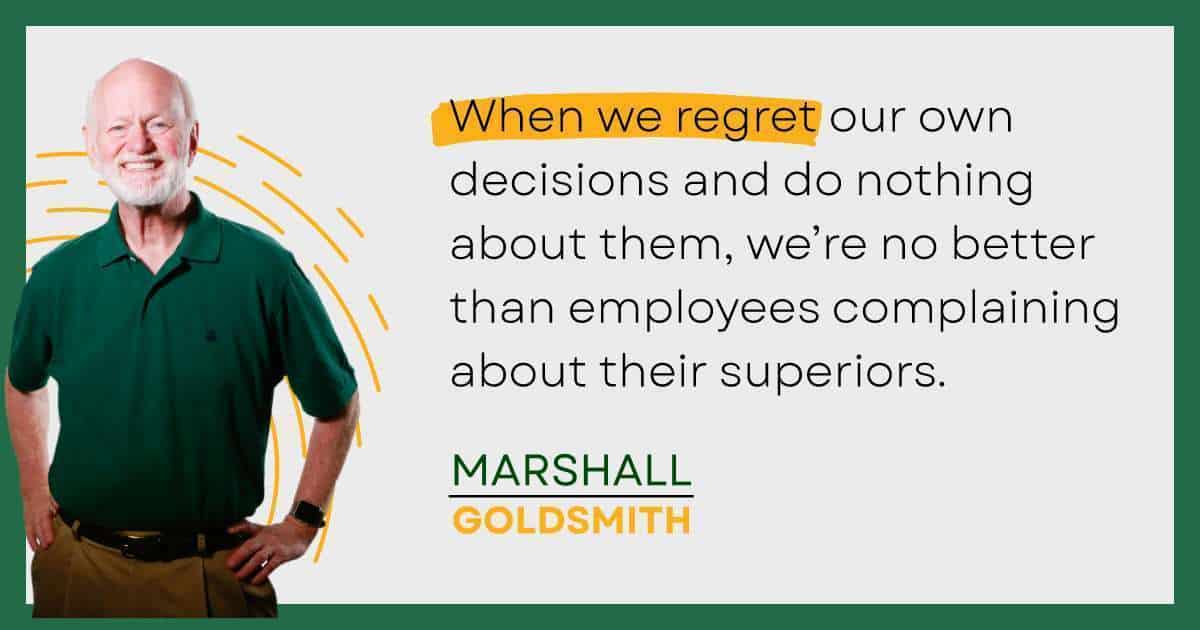Playing Favorites By Marshall Goldsmith There’s a reason I devote...
Listen to what General Mills CEO Steve Sanger recently told 90 of his colleagues: “As you all know, last year my team told me that I needed to do a better job of coaching my direct reports. I just reviewed my 360-degree feedback. I have been working on becoming a better coach for the past year or so. I’m still not doing quite as well as I want, but I’m getting a lot better. My coworkers have been helping me improve. Another thing that I feel good about is the fact that my scores on ‘effectively responds to feedback’ are so high this year.”
While listening to Steve speak so openly to coworkers about his efforts to develop himself as a leader, I realized how much the world has changed. Twenty years ago, few CEOs received feedback from their colleagues. Even fewer candidly discussed that feedback and their personal developmental plans. Today, many of the world’s most respected chief executives are setting a positive example by opening up, striving continually to develop themselves as leaders. In fact, organizations that do the best job of cranking out leaders tend to have CEOs like Steve Sanger who are directly and actively involved in leadership development. That has certainly been my experience. This has also been confirmed by a recently completed research project led by Marc Effron at Hewitt Associates, one of the largest HR consulting firms. Hewitt and Chief Executive magazine put General Mills on their latest list of the top-20 companies for leaders, among such familiar names as IBM and General Electric.
Hewitt found that these organizations tend to more actively manage their talent. They put lots of focus on identifying high-potential people, better differentiate compensation, serve up the right kinds of development opportunities, and closely watch turnover. But crucial to all these efforts were CEO support and involvement.

No question, one of the best ways top executives can get their leaders to improve is to work on improving themselves. Leading by example can mean a lot more than leading by public-relations hype.
Michael Dell, whose company made the Hewitt list, is a perfect example. As one of the most successful leaders in business history, he could easily have an attitude that says, “I am Michael Dell and you aren’t! I don’t really need to work on developing myself.” Michael, however, has the opposite approach. He has done an amazing job of sincerely discussing his personal challenges with leaders across the company. He is a living case study from whom everyone at Dell is learning. His leadership example makes it hard for any leader to act arrogant or to communicate that he or she has nothing to improve upon.
Johnson & Johnson, tied for first on the top-20 list, has successfully involved its executives in leadership development. Its CEOs, formerly Ralph Larsen and now Bill Weldon, and top executive team regularly participate in a variety of leadership-building activities. Having a dialogue with the CEO about his business challenges and developmental needs makes it a lot easier for employees to discuss their own business challenges and developmental needs.
Executive candor can even help turn around a troubled company. Consider Northrop Grumman, the aerospace defense contractor. CEO Kent Kresa inherited a company that had a poor reputation for integrity, a battered stock price, and an unfortunate reputation as one of the least-admired companies in its industry. His leadership team reversed the company’s poor image and engineered an amazing turnaround – ultimately becoming the Forbes’ most-admired company. From the beginning of the process, Kent led by example. He communicated clear expectations for ethics, values, and behavior. He made sure that he was evaluated by the same standards that he set for everyone else. He consistently reached out to coworkers. He didn’t just work to develop his leaders–he created an environment in which the company’s leaders were working to develop him.
Unfortunately, in the same way that CEO support and involvement can help companies nurture leaders, CEO arrogance can have the opposite effect. When the boss acts like a little god and tells everyone else they need to improve, that behavior can be copied at every level of management. Every level then points out how the level below it needs to change. The end result: No one gets much better.

In November 2015 Dr. Marshall Goldsmith was recognized as the #1 Leadership Thinker in the World and the top 5 Management Thinker at the Thinkers50 Award Ceremony in London. He was also selected as the #1 Executive Coach in the World by GlobalGurus.org, and one of the 10 Most Influential Management Thinkers in the World by Thinkers50 in both 2011 and 2013. In 2011 he was chosen as the World’s Most Influential Leadership Thinker. Marshall was the highest rated executive coach on the Thinkers50 List in both 2011 and 2013. What Got You Here Won’t Get You There was listed as a top ten business bestseller for 2013 by INC Magazine / 800 CEO Read (for the seventh consecutive year). Marshall’s exciting new research on engagement is published in his newest book Triggers(Crown, 2015).
Please order Triggers at Amazon or Barnes & Noble!

Adding Too Much Value Won’t Get You There By Marshall...
C-Suite Master Class: No, But, However By Marshall Goldsmith Continuing...
The Doerr Institute: Expanding the Market for Coaches By Marshall...
Making Leadership Development Part of the College Degree at Rice...
Sanyin Siang – Winner of the Thinkers50 Marshall Goldsmith Coaching...
Thinkers50 Marshall Goldsmith Distinguished Achievement Award in Coaching – Nominees...
Leading with Influence: What Is Influence360°? By Marshall Goldsmith Founder...
Are You a Dominator, Manipulator, Persuader or Influencer? By Marshall...
Leading with Influence: Redefining Modern Influence Part 2 By Marshall...
My mission is simple. I want to help successful people achieve positive, lasting change and behavior; for themselves, their people, and their teams. I want to help you make your life a little better. With four decades of experience helping top CEOs and executives overcome limiting beliefs and behaviors to achieve greater success, I don’t do this for fame and accolades. I do this because I love helping people!
As an executive educator and coach, I help people understand how our beliefs and the environments we operate in can trigger negative behaviors. Through simple and practical advice, I help people achieve and sustain positive behavioral change.